Equipment Insight: Telehandlers
Technology improves versatility, maintenance and return on investment.
 |
|
Alberto Ortega Moreno |
Growing interest in telehandlers
The evolving needs of modern construction, agriculture, and industrial sectors have created a demand for versatile, reliable and cost-effective equipment solutions. Telehandlers, with their multifunctional capabilities, have proven to be indispensable for equipment rental centers, covering many applications with efficiency and precision.
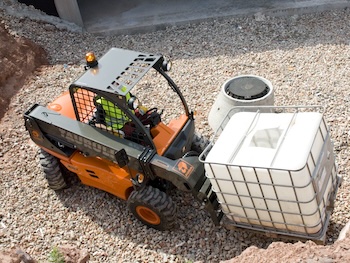 |
|
With multi-purpose capabilities, these telehandlers can handle various tasks ranging from lifting and maneuvering in tight spaces to operating on rough terrain, which is essential for diverse project requirements. |
New telehandler models designed by AUSA, such as the T144 H and T235 H, offer several characteristics that have increased their popularity at equipment rental centers:
Versatility and adaptability: With multi-purpose capabilities, these telehandlers can handle various tasks ranging from lifting and maneuvering in tight spaces to operating on rough terrain, which is essential for diverse project requirements.
Advanced technology and safety features: The latest models incorporate enhanced safety protocols, including overload protection systems and improved visibility, ensuring safer operations which are a significant selling point for rental businesses.
Energy efficiency and environmental compliance: New engines and hydraulic systems are not only more powerful and efficient but also comply with emission standards, making these models more attractive from an environmental sustainability standpoint.
Despite their advantages, new telehandler models introduce concerns for rental centers, primarily around technological complexity and maintenance. AUSA addresses these issues through several approaches:
Training and support: AUSA provides comprehensive training and technical support to ensure that the rental centers' personnel are well-equipped to operate and maintain the new technology efficiently. AUSA offers their customers to feature their machines with AUSAnow, a fleet manager which can improve the efficiency and profitability of rental center’s units by using their mobile phones or computers. The software allows real-time access to maintenance requirements, technical and performance issues and any unexpected movement of machines. This ensures the AUSA vehicle's owner gets the most out of it and reduce downtime by being able to anticipate any requirements.
Enhanced design for easy maintenance: The telehandlers are designed with accessibility in mind, grouping maintenance components together and providing easy access panels which reduce downtime and maintenance costs.
Reliable after-sales services: Our dedicated after-sales support ensures that rental centers receive timely assistance and parts availability, minimizing potential disruptions caused by equipment downtime. Our dealer network is also a point of support which offers the knowledge, expertise and quick response in case of need.
Investing in new telehandler model is a critical decision for rental centers, affected by factors such as return on investment (ROI), operational costs, and market demand. Here’s how AUSA telehandlers can affect ROI:
Higher rental yield: The advanced features and capabilities of new models allow rental centers to have higher rental rates. For instance, the T235H’s superior lift capacity and reach can adapt to a broader range of applications, justifying higher rental fees.
Long-term cost savings: Despite the higher initial investment, the long-term savings on maintenance, coupled with lower fuel consumption and reduced wear and tear, contribute to a more favorable total cost of ownership.
Market differentiation: Offering the latest models can differentiate a rental center in a competitive market, attracting more customers who seek modern, efficient, and compliant equipment for their projects.
AUSA telehandler models not only meet the current demands of the rental market but are also designed with an eye on future requirements. By addressing the concerns related to new technology adoption through robust support and training, AUSA ensures that these models are a profitable investment for equipment rental centers. The strategic acquisition of these advanced machines, supported by a strong understanding of their economic impact, puts rental centers to take advantage on market opportunities and improve their service offerings.
 |
|
Mike Fitzgerald |
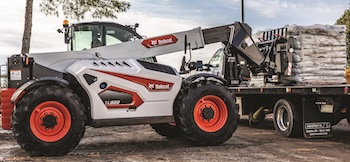 |
|
The Bobcat R-Series telehandler lineup offers the extended reach and superior lift capacity of a heavy-duty telescoping boom combined with a range of attachment offerings for leading versatility. |
Match work mode to job
In December 2021, Bobcat launched the TL619 telehandler and in March 2022, Bobcat launched the TL723 and Tl923 telehandlers. Following in January 2023, the company launched the TL519; these are the four latest Bobcat telehandler models.
The TL723 at 100 horsepower and the TL923 at 135 horsepower come equipped with a state-of-the-art advanced Bobcat Tier 4, turbo-charged engine, delivering powerful, high-torque performance and excellent efficiency. They achieve emissions compliance without the use of a diesel particulate (DPF), which means they do not require a regeneration process for the exhaust system. All Bobcat R-Series telehandler models are equipped with automatic ride control, which reduces materials spillage and enables operators to travel at faster speeds for increased productivity.
The Bobcat TL519 and TL619 come with the Power Bob-Tach mounting system which allows customers to share attachments with other Bobcat equipment.
All R-Series telehandler models also come equipped with four steering modes and five operation modes for the ultimate operator versatility, including:
ECO mode that allows the operator to maintain hydraulic performance without using the engine’s full power so it can work with lower engine speed, less noise and lower fuel consumption.
Smooth Drive mode is ideal for maneuvering across job sites with mild acceleration and deceleration while carrying loads.
Dynamic Drive mode increases responsiveness of the telehandler’s acceleration and deceleration for traveling between tasks.
Flex Drive mode allows the operator to manage the engine speed independently from travel speed.
Advanced Attachment Control mode allows for full auxiliary hydraulic performance.
The Bobcat R-Series telehandler lineup offers the extended reach and superior lift capacity of a heavy-duty telescoping boom combined with a range of attachment offerings for leading versatility. The models also feature a redesigned cab for greater comfort and simplified operation. These machines continue the Bobcat tradition of operator-centric design with optimal visibility, excellent ergonomics, enhanced attachment operation and easy-to-read instrumentation that Bobcat equipment operators will find familiar across R-Series machines. R-Series telehandlers respond quickly and smoothly as operators perform multiple boom and hydraulic functions at the same time.
To get the most out of an R-Series telehandler, Bobcat designs and builds a large selection of standard and hydraulic-powered attachments that can be put to work using the Bob-Tach or power quick-tach mounting systems. All models in the R-Series lineup offer a heavy-duty hydrostatic transmission that delivers smooth, quick power when needed, as well as high wheel torque for digging and pushing.
The TL723 and TL923 have a unique wrap-around rear window that gives the operator a good view to the side and rear of the machine. The TL723 and the TL923 sre also equipped with the Power Quick-Tach attachment mounting system provides robust, compact attachment versatility. The hydraulic lock function allows users to change non-hydraulic attachments safely and quickly without leaving the cab. With the Power Quick-Tach system, operators push a button to retract and release the pins to quickly secure an attachment.
The TL923 hydraulic system, specifically, is designed for faster boom speeds and heavier lifting, provide extra power for smoother control when loaded, and the fastest boom cycle times possible when empty. Operators can achieve faster boom movement at a lower engine speed with improved multifunctioning capability.
The TL923 also features a high-comfort, heated air-suspension seat which adjusts to the operator’s weight for maximum comfort for a long day’s work.
 |
| Lee Tice Product Manager JCB |
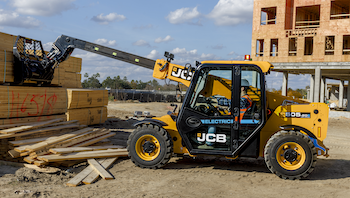 |
|
JCB also makes a battery-electric version of this machine, the 505-20E, that’s perfect for indoor or outdoor work and noise-restricted job sites, and it has zero emissions. |
Labor savings equal higher ROI
New creature comforts are coming into play in telehandler selection. Things like air suspension seats and improved cabs make these machines more desirable and enable operators to be more productive on long workdays.
5The new model machines also have more technology and more attachment options including hydraulic-powered attachments such as tiltrotators and jibs, plus swing forks and rotating screen attachments for the entertainment industry.
Safety improvements are also part of the appeal of the new telehandlers. Things like pulse radar, multiple cameras and bird’s-eye views are becoming more popular and substantially reduce job site accidents and machine damage.
We’re also seeing a growing demand for compact and subcompact telehandlers. For JCB, that’s the 505-20TC. It gives contractors 20 feet of lift height and 5,000 pounds of lift capacity and that can meet many job site demands. JCB also makes a battery-electric version of this machine, the 505-20E, that’s perfect for indoor work and noise-restricted job sites, and it has zero emissions. Overall, there is a better range of sizes and more options from which to choose.
With telehandlers, rental companies are most concerned with knowing that they can service, repair and maintain these machines efficiently and with minimal cost. JCB is incorporating things like oil-evacuation systems that remove the oil through a suction pump and refill the oil reservoir. The technician never has to remove the oil drain plug so technicians can change the oil in 15 minutes, minimize oil contamination and greatly reduce disposal hassles and keep the job site clean. It’s very popular with the rental houses; they actually asked JCB to do this.
JCB also incorporates remote and banked greasing on JCB units. Remote greasing means service personnel don’t have to climb up on the machine to service a grease fitting on a boom. JCB puts the grease points down low on a bank of fittings so all regular greasing can be done while standing at ground level. JCB is also using a dry-oil lubricant rather than white lithium lubricants to increase the longevity of the wear pads on telehandlers.
The complexity of exhaust aftertreatment systems have been a sore point in the past. JCB has addressed that with its 74 and 109 horsepower telehandler options. The 74 horsepower machines don’t have diesel particulate filters (DPF) or diesel exhaust fluid (DEF); JCB’s 109 horsepower machines use DEF but no DPF. The reduction of exhaust aftertreatment leads to increased machine uptime and less maintenance resulting in higher ROI.
Some markets have concerns about availability. The 10,000-pound models are very popular in North America right now. Those are 55- or 56-foot models, depending on the OEM. This remains the most popular machine size by far and with construction booming, rental houses must plan for that. In some cases, they may have to bring in machines from other branches to support a customer or customers with big jobs and tight deadlines.
Rental centers can rationalize the purchase of new telehandler models because they come with all the new features and technology contractors want. Plus, new machines means rental centers don’t need to worry about machine downtime as much. A machine that’s on the job day in and day out is making money; a machine that’s in the shop is not.
The price for used telehandlers is good right now; the retained value is high for these machines. This makes it a good time for rental centers to upgrade their fleets by turning over some of their old inventory. Telehandlers don’t lose their value as fast as earthmoving machines, so there’s plenty of equity to tap into by rental companies.
 |
|
John Boehme |
Technology expands telehandler capabilities
Telehandlers can often reach higher areas that forklifts can’t access, extend further than skid steer loaders and require less training to operate than a crane. In some cases, they are also a more budget-friendly rental option compared to forklifts or cranes. The versatility of these machines allows users to perform various job site tasks with one tool, increasing their return on investment.
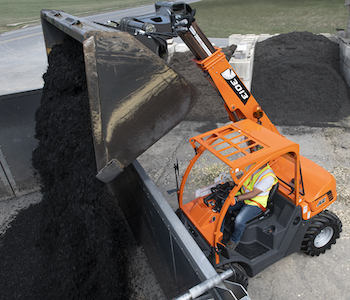 |
|
In the telehandler market, increasing operator confidence and productivity on job sites are the biggest drivers with the introduction of new features and technologies for these machines. For example, JLG and SkyTrak telehandlers equipped with a Load Stability Indication (LSI) system can aid operators by helping them remain within the forward load capacity of the telehandler. |
The opportunities to use these tool carriers aren’t just limited to construction applications; it’s very common for rental centers to rent telescopic handlers for other applications, like grappling pipe in utility installations, transporting hay bales in agricultural settings or loading/unloading loose material on landscaping and hardscaping projects.
JLG is committed to understanding customers’ job site challenges and it partneraing with them to develop solutions that deliver tangible benefits to their businesses. Available in two brands, JLG telehandlers and SkyTrak telehandlers, JLG offers different types of telehandlers to meet rental centers’ — and rental customers’ — needs, including compact, high-reach, high-capacity and rotating models.
JLG engineers develop new features and functionality as a result of JLG teams watching how telehandlers work on job sites, as well as talking with operators that use this type of equipment every day. Receiving input ensures that when JLG launches a product, it’s the right solution for customers.
In the telehandler market, increasing operator confidence and productivity on job sites are the biggest drivers with the introduction of new features and technologies for these machines. For example, JLG and SkyTrak telehandlers equipped with a Load Stability Indication (LSI) system can aid operators by helping them remain within the forward load capacity of the telehandler.
Also, advances in back-up camera technology, like a multi-reverse camera system, can help JLG and SkyTrak operators see more on the backside of the machine. Giving operators more confidence when backing up, this feature increases job site awareness by displaying multiple views from behind the machine — left, right, and rear.
Finally, advances in boom control technology, such as remote boom control, enables JLG and SkyTrak telehandler operators to control the machine’s boom from outside the cab. This feature provides operators with improved visibility during load placement.
Although not specific to telehandlers, digital solutions are also expanding the use of these machines during the initial design and planning stages through finish work. Some examples include virtual reality platforms, BIM libraries and augmented reality apps, which can help rental companies and contractors plan for and select the right equipment for the work at hand. A fully autonomous job site may be in the distant future, but telehandler owners and operators can embrace moments of autonomy through their already connected devices. For example, augmented reality (AR) apps can make machine selection more intuitive, and AR apps can also help with machine visualization to better understand how telehandlers can be used around job sites. Virtual reality (VR) programs can assist in operator training, and building information modeling (BIM) also aids with machine visualization because models look and act as the real equipment on the job.
Another trend is connectivity. Internet of things (IoT) is changing how designers develop equipment and how equipment interacts with each other, operators and technicians. For rental centers and rental customers, equipment becoming more connected provides valuable data throughout the workday for decision-making and planning purposes. The JLG ClearSky Smart Fleet IoT solution provides all owners and users access to critical engine and equipment operational data, including location, engine hours, usage, fuel and battery levels and more.
When considering adding new telehandler models into a rental fleet, rental centers need to understand the wants and needs of their local customer base. Do they need/want models with higher reach or more compact models? Are they looking for models with new technology to help improve job site efficiencies and are willing to pay a higher rental rate for machines with these features? Or are they looking for basic models that lift and place with limited technology? All of these things should be taken into consideration before investing.
Knowing what’s important to the local customer base should help guide rental fleet purchases. If a rental company doesn’t have a good handle on the preferences of their local customer base, they risk stocking new models with new technologies that their customers don’t want — or basic models that don’t have the features customers desire.
Once the purchase decisions are made and new models added to a fleet, there’s a learning. First, the rental company and its sales team must learn what the new model and any associated technology hasto offer not their business and how these same features benefit their customers' businesses. Marketing these models and being able to effectively communicate the customer benefits will positively impact utilization rates. The better job a rental center does at communicating the advantages of the new models, the more likely customers will be to request them, thereby accelerating the user adoption rate.
Bringing on new models with new technology will also require training for service personnel. Ensuring the service team is equipped to support the units once they are in the field is crucial to maintaining a high level of customer support.
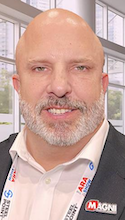 |
|
Joe Leinwol |
Rotating telehandlers increase job site efficiency
The allure of new telehandler models for equipment rental centers lies in their ability to address customer demands.
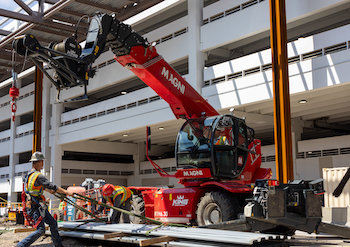 |
| The greatest attraction and benefit of new telehandler models for equipment rental centers primarily revolves around two key factors: parts and product support and service and sales training. |
First, models with superior lift heights and capacities such as Magni rotating telehandlers, with maximum lift heights up to 167 feet and fixed-boom models with lift capacities up to 110,000 pounds enable efficient handling of larger loads and tasks at greater heights, enhancing versatility. This translates to customers expanding their capability while bringing efficiency to each job.
Second, remote control functionality, also available on Magni models, provides operational flexibility and minimizes risks for the customer. This feature, along with a wide range of attachments such as forks, jibs, winches and man baskets allows a contractor to complete jobs with a smaller crew, which helps address the labor shortage.
Safety features remain paramount, and Magni leads the way with LMI (Load Moment Indicator) technology allowing for the extremely safe operation of the telehandlers, which protects the operators and equipment.
New telehandler models, especially Magni’s dynamic lineup, deliver superior performance, and ROI for both the rental company and contractors.
The greatest attraction and benefit of new telehandler models for equipment rental centers primarily revolves around two key factors: parts and product support and service and sales training.
Magni’s commitment to providing extensive parts and product support in the United States underscores its dedication to customer satisfaction. With a substantial investment in stocking parts and a comprehensive inventory in multiple locations around the United States, Magni ensures swift access to essential components, minimizing downtime for rental centers and their customers. Additionally, the Magni telehandler lineup features common components across models, facilitating streamlined maintenance and repair processes throughout the entire product line.
Magni’s focus on training service and sales initiatives further enhances the appeal of Magni telehandlers models to rental centers. Operating two dedicated training centers in Texas and New Jersey, staffed with experienced training specialists, Magni offers comprehensive training programs tailored to both sales and service personnel.
In addition, Magni provides regional service managers to support Magni’s robust dealer network.
Magni’s train-the-trainer programs empower rental center staff to effectively disseminate knowledge and skills, enabling them to provide exceptional service and support to their customers.
The emphasis on robust parts support and comprehensive training services reinforces the value proposition of Magni telehandler models, fostering strong partnerships with equipment rental centers and driving mutual success.
Rental centers can rationalize the purchase of new telehandler models based on ROI and other factors by focusing on long-term rentals and taking a customer-centric approach.
Magni’s rotating telehandler models are tailored for long-term rental agreements, offering rental centers a sustainable revenue stream over extended periods. Magni rotating telehandlers provide consistent demand and utilization, maximizing ROI over the equipment's lifecycle.
When evaluating new telehandler models, rental centers should prioritize understanding how these offerings address the needs of their customers. By aligning telehandler capabilities with customer requirements, rental centers can position themselves as trusted partners, fostering long-term relationships and securing repeat business.
 |
| Steve Kiskunas Product Manager Manitou |
Attachment interface increases utilization and ROI
Manitou’s most recent introduction to the rental market, the MTA 519 telehandler, one of the biggest things is the skid steer/CTL attachment interface. In addition to the traditional forks of a telehandler, these machines can operate countless standard-flow and non-hydrauliuc skid steer attachments that the rental center or the renter may already own. This level of versatility creates significant opportunity for increases in utilization as the machine can do so much more than
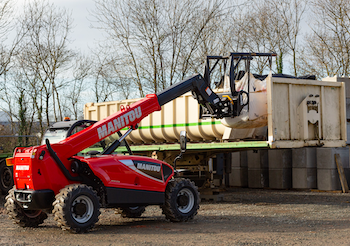 |
| The Manitou 519 telehandler features a tool interface that can carry a wide variety of attachments used on skid steer loaders and compact track loaders. |
This has many benefits for rental businesses. If you can rent a series of attachments out to the same customer who is renting the telehandler, you can increase the total price per transaction, which ultimately increases the profitability of that machine over its service life in your operation.
Manitou has gone to great lengths to lower the total cost of ownership of these machines with regular service points that are easier to access. Telematics is standard for rental businesses to better monitor machine utilization, performance and health. Manitou has also flooded its dealer network in advance of the machine’s launch with common parts and consumables to prevent downtime.
The goal of all of these things working together is to increase the profitability of these machines in the time that a rental business owns them. If the term they own it for is three years, Manitou has implemented things in this machine that will increase its profitability over that length of time, while also lowering its total cost of ownership. That translates to pure profitability.
Rental centers are always wary of anything “new” because there is always a certain level of uncertainty. There’s an old cliché saying in the equipment business of “you never want to buy the first generation of a new machine – let someone else figure out its problems and buy the second generation”. Manitou avoids that with new introductions like the MTA 519 both through extensive quality review and testing, but also in that Manitou originally built the machine with the best features of a previous model and improved upon the performance and utilization of the machine.
Equipment is also now coming with so much more in the way of intelligence that helps businesses be smarter in how they are building their rental fleet. It’s so much easier to analyze utilization, examine operational costs, and understand how a machine is being used by their customers.
Manitou is showing a greater commitment, along with our dealer network, to work in greater partnership with rental businesses. There’s still a problem in the industry, in general, with equipment dealers viewing rental businesses as competition. We all know that, based on the continued growth of the rental market, there’s more than enough rental business to go around. Manitou works with its dealers to help them understand that partnering with independent rental businesses is a smart business investment and helps improve everyone’s business; a rising tide raises all ships.
Lowering total cost of ownership (TCO) is key to improving ROI. TCO is a benchmark in every new machine Manitou introduces. That’s not just the cost of time and materials to perform maintenance – although that’s a critical part of it. It’s how that affects downtime. Increased uptime equals more time over the course of the machine’s life making money.
It’s also tied to utilization. Manitou brings these machines to the rental market with a focus on driving real improvement in performance and versatility, which in turns increases utilization and profitability. With these newer generation machines, Manitou is doing everything it can to lower the cost burden of these machines while increasing the opportunity for profit.
 |
| Tim Palosaari Product Management Analyst Pettibone |
Simpler maintenance helps ROI
Offering the best product at a low cost of ownership is integral to Pettibone’s values. A higher purchase price can be more easily rationalized when examining quality and long-term cost-effectiveness. Ultimately, it comes down to choosing the options that best fit a rental center’s needs and having a machine that will produce effective results in their fleet.
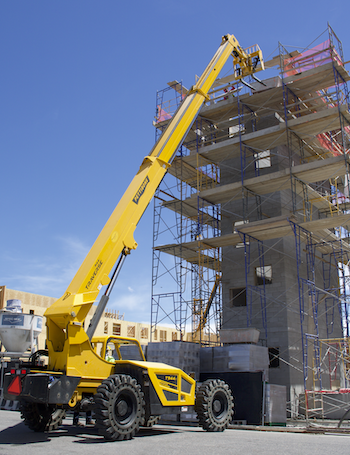 |
|
Pettibone X-Series telehandlers feature a side-mounted engine compartment that offers easy accessibility for daily service checks. |
Rental centers naturally tend to lean toward carrying machines that deliver the best return on investment (ROI) and total cost of ownership is a big piece of the ROI puzzle. Maintenance, fuel efficiency and repairs are all decision-making factors when deciding what new telehandler to purchase. Even the highest quality machines require maintenance but making that maintenance faster and easier to complete allows a rental center keep utilization high, which drives profitability.
Pettibone X-Series telehandlers feature a side-mounted engine compartment that offers easy accessibility for daily service checks. Grease points are easily reached as well. It’s important to grease telehandlers regularly, as well to check the boom’s wear pads to ensure they’re at the proper tolerance. Pettibone’s telehandler cab features an all-steel dash, so one can simply pressure-wash the interior without fear of damaging cab components.
Utilizing telematics software is another way to increase ROI. Rental owners can readily access data that gives basic information like equipment location. Telematics also help identify any issues occurring with the machine so those items can be addressed before they become serious problems.
Certain issues can be quickly diagnosed using the telematics dashboard on a computer or smartphone app. This is particularly beneficial when a telehandler is on a remote jobsite, since field technicians can learn more information about the problem before they arrive.
In fact, depending on the affected components, telematics can sometimes let you know the exact part number that needs replacing. Techs can then ensure they have the necessary replacement part before traveling to make the repair.
Many rental customers – even experienced ones – aren’t always familiar with a particular telehandler brand or model, so operator errors that lead to costly breakdowns are possible. Having telematics in place to receive proper alerts can proactively ensure both the customer’s uptime and the long-term health of the telehandler in your fleet.
Pettibone’s X-Command telematics program comes standard for two years on X-Series Extendo and Traverse telehandlers. The system is also available as a retrofit for existing X-Series machines. X-Command allows owners to both look at current equipment data and generate reports that can assist with planning ahead on fleet maintenance.
Telehandler manufacturers are also continuing to emphasize safety when considering overall machine design and specific features. Operator visibility is a big focus. Some telehandlers are promoted as having excellent visibility from the cab, but seemingly clear sightlines can vanish once the machine is put into a real working situation. Ideally, the telehandler’s chassis and boom structures should be designed to provide visibility in all directions around the machine.
Telehandlers in the Pettibone X-Series lineup use a single lift cylinder, rather than two cylinders, to improve rear sightlines for the operator. Pettibone also offers an optional rear-view camera system and larger units equipped with outriggers still allow visibility to the fork tips. Additionally, Pettibone’s side-mounted engine compartment is situated to provide good curbside visibility.
Pettibone remains the only manufacturer producing a telehandler with a horizontally sliding boom. All models in the Pettibone Traverse lineup offer up to 70 inches of traversing boom travel. This allows users to safely land loads without having to coordinate multiple boom functions or drive the machine physically forward or back.
 |
|
Malcolm Early |
Technology drives repairability
Any technology that contributes to drive ROI will be popular in 2024. Machine reliability and longevity, as well as flexibility for fleet movement, are increasingly important.
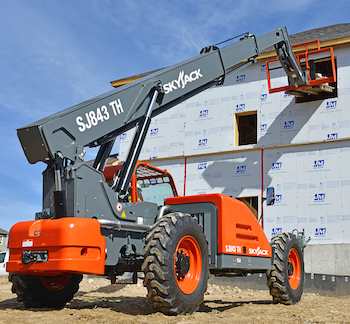 |
| Skyjack’s telehandlers use Skycoded, a proven and simplistic control systems using Skyjack’s color-coded and numbered wiring system to make Skyjack machines the easiest to troubleshoot. |
Skyjack’s telehandlers use Skycoded, a proven and simplistic control systems using Skyjack’s color-coded and numbered wiring system to make Skyjack machines the easiest to troubleshoot. Using a relay-based control system allows Skyjack’s telehandlers to operate with simpler components, resulting in less maintenance and lower costs.
Advances that incorporates flexibility, such as Flexcab, will also be impactful in the coming years to allow for fast response to rental customer demands. Flexcab is an innovative cab design that allows fleet operators to easily convert between open and enclosed cabs with simple hand tools, providing increased flexibility for fleet movement and fast response to customer demands.
Over the years, there have been tremendous advances in equipment across the board. This is a very exciting time but it does also mean that even the most experienced operators could be unfamiliar with a machine. Many common errors in operation and safety practices can be avoided by reading the manual or Quick Start guides.
Skyjack offers a variety of training options for all products that it manufactures. Operator and trainer courses are available at Skyjack’s Guelph, Ontario, Canada head office or on-site, as well as training kits for experienced trainers to deliver training in compliance with MEWP standards CAN/CSA-B354.8:17 and ANSI/SAIA A92.24-2018 and Telehandler standards CSA B335-15 (R2020) and ANSI/ITSDF B56.6-2016. Skyjack and IPAF training programs are generic and applicable to all brands of machines.
When it comes down to it, ROI drives the rental business. Equipment is an asset to rental companies and it needs to be easily repairable with low downtime. Technology implementation needs to drive productivity and ROI. Skyjack’s focus is on rental and experts here understand rental better than any other manufacturer and take pride in the ability to easily conduct business with customers and prospects.
 |
|
Senior Global Product Manager |
Search for well-tested units
Telehandlers are highly utilized on job sites. They are great multi-taskers: directly performing productivity work or supporting other operations by ensuring materials are where they’re needed, when they’re needed. Overall, they support an organized job site, which is more efficient and safer.
To get the most out of a telehandler and realize the benefits of its high utilization, Genie is focused on maximizing uptime and minimizing the machine’s total cost of ownership. That includes designing Genie telehandlers for durability and reliability to keep uptime high, and when they do need maintenance, making them easy to service so they can quickly return to rent. By keeping Genie telehandlers robust and simple, technicians know what to expect regardless of the model.
One way Genie does this is with simple designs that have about 75 percent of parts in common across the product line. This reduces the number of parts a rental company needs to stock, and makes servicing equipment more straightforward for technicians.
Finally, attachments also support the high rental utilization. They present an add-on rental item for the rental company and increase the flexibility of the equipment for the end user. Most of Genie’s new telehandler attachments can be used across the range of Genie telehandlers, which increases fleet versatility, and contributes to better rental return on invested capital (rROIC).
Because of the wide variety of trades that rent telehandlers for an even wider variety of applications, rental centers are looking for telehandlers that will stand up to the realities of the job site. They need to be simple to operate and durable. Genie’s GTH 1056, introduced in 2021, underwent a significant amount of testing — more testing than any other Genie telehandler previously brought to market — to ensure that it was built for durability and performance. Customers provided critical feedback after operating multiple units for hundreds of hours on real job sites. The result is a telehandler that features a 30 percent stronger boom and chassis. The boom with mid-pivot point uses a single lift cylinder. This simpler configuration, combined with a wider, stiffer horsehead efficiently transfers loads in applications imposing high stress on the boom, such as pipe handling or suspended loads. Those same features were incorporated in the redesigned GTH-1256, launched in 2023.
Rental centers can rationalize the purchase price of new telehandler models by investing in equipment with a low total cost of ownership (TCO) and high uptime. It’s not just the initial purchase price, but also how much it costs to replace parts, and how often you have to do that, as well as how easy it is to maintain, and the time and expense that goes into that. Because anytime a machine is out of service for maintenance or repairs, it costs rental businesses in terms of actual expense and lost revenue.
Purchasing a telehandler from an OEM that offers a wide variety of attachments should also be a consideration. As mentioned previously, attachments provide a way for rental companies to maximize their rental rate, support their end user customer by offering ways to work more productively, and further supports rental utilization.
Finally, TCO also takes into account residual value at the end of a machine’s life.
--ends--
This article originally appeared in the July-August 2024 issue of Pro Contractor Rentals magazine. ©2024 Urbain Communications LLC. All rights reserved.








